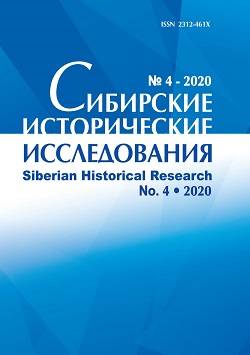Impact of migrations on paleodemographic characteristics of the Russian population, 17th to 19th centuries
The article presents an evaluation of paleodemographic characteristics of the Russian population in the modern period and assesses migration as a possible factor that contributed to them. Analysis is made on 64 skeletal series from excavations of 17th-19th century urban cemeteries. It is shown that Siberian samples differ from European Russia samples in that they feature a significantly higher proportion of children and a relatively low proportion of adults. In general, the identified differences tend to match the differences between the samples collected on 'early settlers' and so-called 'old-timers', irrespective of territory of residence. One of the main explanations for the specific age-at-death distribution found in Siberians is seen to lie in the distinctive migrant age-sex distribution and in the high rates of population growth east of the Urals. Significant discrepancies are found between life expectancy estimates based on paleodemographic values of the juvenility index and on nineteenth century official statistics. These are most likely to be due to the discrepancies between the age-at-death distributions for rural and urban population, as well as to the insufficient representativeness of the skeletal series. It is shown that the average percentage of working age people is higher in samples from military and industrial settlements than in rural population groups. This can be explained by both differences in the age-sex composition of the population and relatively high mortality rates in some age groups in the two aforementioned types of settlements.
Keywords
paleodemography,
historical demography,
physical anthropology,
European Russia,
Siberia,
modern period,
migrations,
urban populationAuthors
| Shirobokov Ivan G. | Peter the Great Museum of Anthropology and Ethnography (Kunstkamera) | ivansmith@bk.ru |
Всего: 1
References
Батиева Е.Ф. К антропологии населения Азовской крепости XVII-XVIII веков // Историко-археологические исследования в Азове и на Нижнем Дону в 2015-2016 гг
Азов: Изд-во Азовского музея-заповедника, 2018. Вып. 30. C. 399-416
Бессер К., Баллод К. Смертность, возрастной состав и долговечность православного населения обоего пола в России за 1851-1890 годы. СПб.: Типография Императорской Академии Наук, 1897
Брук С.И., Кабузан В.М. Динамика численности и расселения русского этноса (16781917 гг.) // Советская этнография. 1982. № 4. С. 9-25
Васильев С.В., Боруцкая С.Б. Палеоантропологическое исследование первопоселенцев г. Липецка (XVIII в.) // Актуальные вопросы антропологии. Минск: Беларуская навука, 2011. Вып. 6. С. 396-418
Васильев С.В., Боруцкая С.Б. Палеоантропологический анализ погребений из Кашинского Кремля (раскоп Воскресенский 1) // Вестник антропологии. 2013. № 3 (25). С. 107-120
Васильев С.В., Боруцкая С.Б. Комплексное палеоантропологическое исследование населения, оставившего средневековый могильник Исупово (Костромская область) // Беларускае Падзвшне: вопыт, методыка i вынт палявых i мiждысцыплшарных даследаванняу. Наваполацк: ПДУ, 2011. С. 5-13
Демографическая история Западной Сибири (конец XIX-XX вв.). Новосибирск, 2017
Зверев В.А. Люди детные: воспроизводство населения сибирской деревни в конце имперского периода. Новосибирск: Изд-во НГПУ, 2014
Ивонин А.Р. Западносибирский город последней четверти XVIII - 60-х гг. XIX в. в системе региональных социально-экономических отношений: дис. ... д-ра ист. наук. Барнаул, 2000
Миронов Б.Н. Русский город в 1740-1860-е годы: демографическое, социальное и экономическое развитие. Л.: Наука, 1990
Молодин В.И. Кресты-тельники Илимского острога. Новосибирск: ИНФОЛИО, 2007
Новосельский С.А. Смертность и продолжительность жизни в России. Петроград: Типография МВД, 1916
Панишев Е.А. Медицинское обслуживание и охрана здоровья населения Тобольской губернии во второй половине XIX - начале ХХ в. // Известия Алтайского государственного университета. 2009. № 4, т. 3. С. 161-164
Рашин А.Г. Население России за 100 лет (1811-1913). М.: Государственное статистическое издательство, 1956
Рейс Е.С., Савенкова Т.М. Демографическая характеристика населения города Красноярска XVII - начала XX вв. (по материалам православных некрополей) // Преодоление времени и пространства: статьи по актуальным проблемам охранно-спасательных работ на памятниках археологии. Иркутск: Изд-во Института географии им. В.Б. Сочавы СО РАН, 2019
Сарафанов Д.Е. Смертность населения в Барнауле в XIX в. // Миграции и постмиграционные сообщества (Алтай - Казахстан, XIX-XX вв.). Барнаул: Изд-во Алт. ун-та, 2007. С. 182-212
Федосова В.Н. Развитие современной палеодемографии (методические проблемы) // Российская археология. 1994. № 1. С. 67-76
Широбоков И.Г. Возрастное распределение умерших в России XVII-XIX вв.: обманчивая палеодемография // Сибирские исторические исследования. 2019. № 4. С. 180-196.
Bocquet-Appel J.P., Masset C. Expectancy and false hope // American Journal of Physical Anthropology. 1996. Vol. 99. P. 571-583
DeWitte S.N. Demographic anthropology // American Journal of Physical Anthropology. 2018. Vol. 165. P. 893-903
Hoppa R.D. Paleodemography: Looking back and thinking ahead // Paleodemography: age distributions from skeletal samples. Cambridge, 2002. P. 9-28
McCaa R. Calibrating Paleodemography: The Uniformitarian Challenge Turned. 1998. URL: http://users.pop.umn.edu/~rmccaa/paleo98/index0.htm
McFadden C., Oxenham M.F. Rate of natural population increase as a paleodemographic measure of growth // Journal of Archaeological Science: Reports. 2018. Vol. 19. P. 352-356.
Milner G.R., Wood J.W., Boldsen J.L. Paleodemography: Problems, progress and potential // Biological Anthropology of the Human Skeleton. Wiley-Blackwell, Hoboken, NJ., 2018. P. 593-633
Sattenspiel L., Harpending H. Stable population and skeletal age // American Antiquity. 1983. Vol. 48, No. 3. P. 489-498
Ubelaker D.H., Longeway A. Skeletal age estimation of the living and the dead: the evolution of methodology // Age Estimation. 2019. P. 29-40

